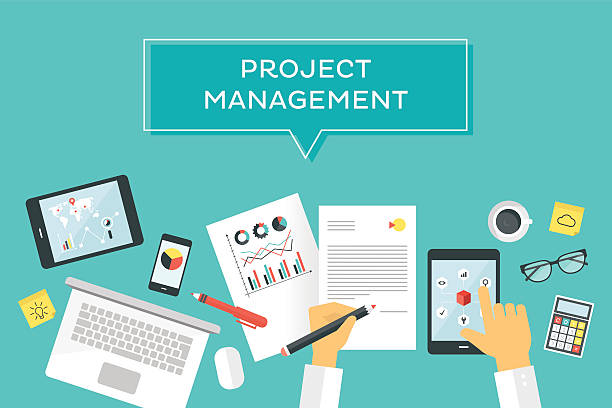Project management is a field that requires various skills and expertise to be effective. In this article, we discuss the importance of project management, how it can help you work more efficiently, and the best practices for proper project management.
What is project management?

Project management is the process of coordinating and managing a project, often from conception to completion. A project manager is responsible for ensuring that all aspects of the project are executed as planned, on time, and within budget.
Project management methodology includes setting expectations with stakeholders, gathering requirements and designing a plan, initiating and leading the project team, monitoring and managing progress, resolving conflicts, and closing the project.
There are many different applications for project management. Some common uses include manufacturing, software development, construction, transportation systems design and management, medical device development, and environmental engineering.
The goal of any project is to achieve a specific outcome. This outcome may be tangible (such as building a bridge) or intangible (such as creating a new product or service).
To achieve the desired outcome, a project must have clear goals, objectives, and responsibilities.
| ‣ The most important element of any successful project is the team involved. A good project manager will assemble an effective team that can work together to create a successful outcome. |
| ‣ The team should have complementary skills and knowledge so that everyone can contribute to the success of the project. |
| ‣ A good project manager will establish clear communication channels with all stakeholders. |
| ‣ Project management is most commonly used by organizations with multiple teams working on a common project. However, it can also be used by single individuals or small groups. |
Some reasons why an organization might choose to use project management include:
- To improve communication and coordination among team members
- To ensure that the project goals are met
- To reduce the risk associated with projects
- To improve transparency and accountability for progress
- To improve team productivity and efficiency
- To improve the quality of work
- To provide continuous project governance to other stakeholders.
Who is involved in project management?
There are a few people that are typically involved in project management skills. The project manager is typically the person who is responsible for leading and managing the project.
Other people who may be involved in a project include the stakeholders, the team members, and the clients.
When should I start a project?
There is no single answer to this question since it depends on a variety of factors, including the nature of the project, its scope, and the team’s skills and resources. However, some general tips on when to start a project can help you make the best decision for your organization.
- First, always consider the time and money needed to complete the project. If the projected timeline and cost are too high, it may not be worth starting.
- Second, decide whether the project is necessary or beneficial. If it’s not essential, it may be better to wait until more resources are available or until the situation changes.
- Finally, consider whether the team is capable of completing the project on time and within budget. If not, it may be best to pull the plug early.
When is the best time to start a project?

There is no definitive answer to this question as it depends on a variety of factors. However, some experts suggest that the best time to start a project is when you have a clear understanding of the task at hand and when the necessary resources are available.
How do I calculate my estimated project completion time?
When estimating the time required to complete a project, it is important to consider a variety of factors.
Some key considerations include the project scope, the team size and skills, and the types of tasks involved.
Other factors that can influence completion time include infrastructure dependencies, weather conditions, and software bugs.
Once you have an estimate for the overall project duration, you can use this information to plan your work activities and budget accordingly.
What are the three steps of a well-managed project?
1. Define the project scope.
2. Select the right project management methodologies.
3. oversee and manage project team members.
Who is responsible for project management?
There is no one-size-fits-all answer to this question. Depending on the size and concept of project complexity, the responsible party may vary.
However, in general, the person who initiates a project and coordinates all its activities is generally known as the project manager.
Other key roles include stakeholders (those who have an interest in the project), team members (those who will be working on the project), and resources (such as money, time, equipment, and materials).
When should I start using project management?
There is no one answer to this question either. Like most things in life, starting out slowly and gradually building
When does project management happen?
Project management happens when a group of people works together to complete a task. This task can be anything from building a house to writing a paper.
It is important that the group has a plan and they stick to it, or else the project will not be finished on time or in the way that was planned.
Projects are planned and executed by teams of people. Each individual is needed to help with the task so they work together as a team.
Up to this point, we have seen that projects can be broken down into smaller tasks which are then sub-divided even further into more specific tasks.
For example, in order for a project team to build an alternative fuel car, it will start off with the rough design phase where some of the basic specifications such as engine power and price will be decided on.
During this phase, design specifications and details will be decided on so that the car can be built.
Once the basic design is agreed upon, a production schedule can be put together, and work started on creating the manufacturing equipment necessary to build the car.
One of the most important things to think about when planning any project is how many people need to be involved in order for it to happen at all.
- This can of course be very hard to decide as every company or task may require different skills and qualifications. If a company such as Volkswagen is to create a new car, they will likely have many people working on the project, each with their own role.
- One of the most important roles is that of the designer who will be responsible for creating the car and all of its parts.
- Their job will be to create something which they believe people would want to buy so they can market it. The process from concept design to completion is known as product development.
- From idea to finished product, this process can take many years and involve many people.
- As well as creating a new car, Volkswagen can also create an essential part to the car which is a key component.
- This may be a vital component that helps to improve the performance of a car or it might be something that keeps the car in good working order such as tires.
- Having this particular part manufactured by another company will free up Volkswagen to concentrate on other parts of the project.
Who manages a project?

Project managers are responsible for managing projects from start to finish. They typically oversee budgets, timelines, and resources while working with multiple stakeholders.
They must have strong project management skills and be able to handle communication with a variety of people.
What is a project manager’s role in a law firm?
Projects within the legal industry can be as large or small as necessary, from simple document reviews to complex litigation.
Most projects are initiated by an attorney with a brief, but that doesn’t mean that the project isn’t managed by a project manager.
In most cases where there isn’t an attorney on board, the project manager works closely with attorneys and paralegals to ensure deadlines are met and tasks are completed.
What does a project manager do?
Project managers serve as the focal point for projects within the legal industry. They are responsible for identifying resources and information needed to complete the project, establishing goals, creating a timeline, and overseeing progress on the project.
In addition to managing the work of others, a project manager must be able to coordinate and communicate with people across departments.
They must be self-driven with an ability to work under pressure.
Benefits of using project management for businesses and organizations

There are many benefits to using project management for businesses and organizations. Here are just a few:
1. Increased efficiency – Project management can help businesses manage their time and resources more effectively, leading to greater efficiency in the overall process.
2. More accurate planning – With proper project management, businesses can ensure that their plans are consistent with reality and take into account any potential obstacles that may arise.
This helps to prevent potential disasters from happening and ensures a successful outcome for the project.
3. Reduced risk – By taking steps to organize and manage projects properly, businesses can reduce the risk of experiencing any unforeseen complications or issues along the way.
This minimizes the amount of stress that employees may experience, which can lead to increased productivity overall.
There are many benefits to using project management for businesses and organizations. Here are just a few:
1. Increased efficiency – Project management can help businesses manage their time and resources more effectively, leading to greater efficiency in the overall process.
2. More accurate planning – With proper project management, businesses can ensure that their plans are consistent with reality and take into account any potential obstacles that may arise. This helps to prevent potential disasters.
3. Good communication – Since each project is inherently different, a proper organization of the work allows teams to communicate effectively and efficiently with one another.
This helps them to stay in touch with what’s going on, as well as ensuring that they’re able to react quickly if there are any issues.
4. Decrease risk – Businesses can use project management to help ensure that their projects are safe and accurate, which in turn reduces the chances of catastrophic events from happening, such as fires, floods, or other disasters. This can help companies to avoid these risks and keep everything running smoothly.
5. Time management – In order to be productive on a daily basis, it’s important that project managers are able to manage their time effectively.
This helps them to be able to do everything they need to get done in a timely manner, which allows them to make sure schedules aren’t constantly being overrun with things that have been scheduled for later on down the road.
What are the roles and responsibilities involved in managing a project?
When undertaking a project, there are typically four key players: the customer, the project manager, the team lead, and the resources.
The customer is responsible for defining the goal of the project and specifying what they need from the project.
The project manager is responsible for overseeing the project and ensuring that it meets customer requirements. The team lead is responsible for managing the team and ensuring that they are carrying out tasks according to schedule and budget.
The resources are responsible for providing the necessary resources needed for the project to be successful. To effectively manage projects, it is important to involve all of the key participants in the planning process.
Participants will have different viewpoints on what it takes to complete a project successfully and each participant has their own strengths and weaknesses that can impact the project.
By involving all participants in the planning phase, there is an opportunity for everyone involved to contribute new ideas, share information and work together towards common goals.
The involvement of all parties will also increase the chances that the team will be able to reach its goal.
This is because it will help form alliances and develop trust between the parties in order to encourage an efficient team effort.
The planning phase can be divided into 3 main parts:
Analysis of the project goal and requirements Analysis of the current situation, including data regarding stakeholders’ concerns Assessment of future situations and requirements
1. Analysis of the Project Goal and Requirements – Planning is a way to ensure that you are able to meet your goals once you have started working on a project. This is where you put your team together to create a plan for the project or program that you are working on. This process helps in identifying what features need to be developed, how they will be developed, who will develop them, and when the delivery of these features should take place.
2. Analysis of Current Situation – The analysis of the current situation involves taking stock of all the requirements that you have and then deciding how these will be used once the project has started. It is important when planning a project that you know the features and functionality that you are looking for so that you can determine if your requirements are met or not. You need to understand that development programs cannot be developed without a clear assessment of how these features will be used.
3. Development Activities – When you have decided about the features and interfaces that the project is going to deliver, then you can move on to developing these features. It is necessary to know what type of development activities are needed so that proper estimation of time can be done.
How Can We Help Your Organization?
Project management is a critical part of any organization’s success. However, it can be a complex project’s process with a lot of responsibilities on the part of both the project manager and the team members.
At KPMG, we understand the importance of project management and are here to help you get the most out of your projects.
We offer a wide range of services to help you manage your projects successfully. From providing advice and guidance throughout the process to providing specialist project management services, we can help you achieve your goals.
If you’re looking for someone to manage your entire project from start to finish, our team can provide that as well.
We have a wealth of experience in all areas of project management, so we can take care of everything from planning to execution.
Sustainable Project Management practices and techniques are currently the most effective way of managing projects in a sustainable manner for both the project sponsor and other stakeholders.
The companies we work with have varying needs and our solutions can be tailored accordingly, from stand-alone project management to specific areas of projects like construction, e.g.
master plan and design, or more generic project management such as planning and feasibility studies.
We employ a number of techniques to help our clients achieve their objectives and our projects are always carried out in accordance with best practice protocols.
We have worked successfully on projects in the fields of sustainability, infrastructure, planning and design, development, mining, and health.
When do we use project management?

There are many different definitions of project management, but the most common one is the process of organizing, managing, and controlling resources to achieve specific goals.
- First, you can use it when you have a new project that you don’t know how to manage or when you have an existing project that isn’t meeting your expectations.
- Second, you can use it when you need to improve the efficiency or quality of your projects. Finally, you can use it to prevent projects from getting out of control.
Is there a process to project management? Yes—and we break down all five phases
There are five phases of project management: initiation, planning, execution, monitoring and control, and termination. Initiation is when a project is brought to mind or created.
Planning happens in the early phases of the project as team members work together to identify what needs to be done, how it will be done, and when it will be done.
Execution involves actually doing the work on the project. Monitoring and control are keeping everyone aware of the progress of the project and making sure that everything is going according to plan.
And finally, termination is when the project is finished and everyone can move on to their next project.
There are many different processes that can be used for each phase of a project, but there are some common elements that are always involved.
In every phase, you need a plan that sets out what needs to be done and when it will be done. You also need an accurate estimate of how much work will be required to complete the project successfully.
You must also have a system in place for tracking progress and making sure that deadlines are met. And finally, you need to have mechanisms in place for resolving any problems that may arise during the project.
There is no single plan that will work for all projects. What is required depends on the type of project and what it is being used for.
A common planning process in construction projects involves using a complete set of plans, specifications, and other documents in a systematic way to ensure that every aspect is considered and carried out properly.
How can you build a productive project team?
Building a productive project team is essential to any successful project.
Here are six tips to help you achieve success:
1. Know your team’s strengths and weaknesses. Identify which members of your team are best suited for specific tasks, and give them the opportunities to do their best work.
2. Give your team members clear and concise instructions. Let them know what they need to do, when they need to do it, and how they are expected to complete it.
3. Encourage team collaboration. Help your team members share ideas and resources so that they can work together as a unified force.
4. Foster a positive environment for creativity and innovation. Provide your team members with the space and resources necessary to be creative and innovative thinkers.
5. Celebrate successes together. Let your team know how proud you are of their achievements, and reward them for their hard work and dedication.
Who uses project management?

Project management is a process of organizing, controlling, and monitoring the work of teams to create a goal-directed outcome.
It is used in a variety of industries, including information technology, manufacturing, construction, medical services, and finance.
While project management is most commonly used by organizations with multiple teams working on a common project, it can also be used by single individuals or small groups.
FAQ {FAQ {Frequently Asked Question}
Who uses project management?
Project management is a process of organizing, controlling, and monitoring the work of teams to create a goal-directed outcome.
It is used in a variety of industries, including information technology, manufacturing, construction, medical services, and finance.
While project management is most commonly used by organizations with multiple teams working on a common project, it can also be used by single individuals or small groups.
What who when project management
Project management is a field that requires various skills and expertise to be effective. In this article, we discuss the importance of project management, how it can help you work more efficiently, and the best practices for proper project management.
What is project management?
Project management is the process of coordinating and managing a project, often from conception to completion.
A project manager is responsible for ensuring that all aspects of the project are executed as planned, on time, and within budget.
Project management methodology includes setting expectations with stakeholders, gathering requirements and designing a plan, initiating and leading the project team, monitoring and managing progress, resolving conflicts, and closing the project.
There are many different applications for project management. Some common uses include manufacturing, software development, construction, transportation systems design and management, medical device development, and environmental engineering.
Who is involved in project management?
There are a few people that are typically involved in project management skills. The project manager is typically the person who is responsible for leading and managing the project.
Other people who may be involved in a project include the stakeholders, the team members, and the clients.
When do we use project management?
There are many different definitions of project management, but the most common one is the process of organizing, managing, and controlling resources to achieve specific goals.
First, you can use it when you have a new project that you don’t know how to manage or when you have an existing project that isn’t meeting your expectations.
Second, you can use it when you need to improve the efficiency or quality of your projects. Finally, you can use it to prevent projects from getting out of control.
Related Term
- Why Did Earth Log Go Out Of Business?
- Adroit Marketing INC
- A Dependable and Appealing Way for Managers
- Why Do Businesses Use Letterheads And Logos?
- Which Resource Management Task Establishes?
- Which Best Compares And Contrasts Management And Marketing?
- What is Financial Strategy | Financial Management
- Who is the principal federal official for domestic incident management?
- Which Resource Management Task Deploys or Activates Personnel And Resources
- Which Type of Business Is Strong Steel Manufacturers & Structural Steel
- How To Start Mustard Oil Business Plan
- What Is B2k Marketing | B2k Media Marketing?
- What Is B2k Marketing | B2k Media Marketing?
- What Type of Agreement Is Used To Form A Partnership Business Partnership Agreement?
- How Can The Extensibility of A Platform Benefit a Business?
- What Kind of Business Organization Are Caleb And Anna Operating Under Now?
- What Must An Entrepreneur Assume When Starting A Business Entrepreneurship?
- How Can Formal Business Documents Help Managers Solve Problems Resources
- What is Surrogate Advertising Strategy?
- How To Start A Tumbler Business?
- Which of The Following Statements Is True About Business Intelligence
- Why Are Slide Presentations Universal In Business Environments?
- Business Yoga In Astrology
- How To Play Business Game?
- Understand The Umbrella Branding
- Which Helps Enable An Oligopoly To Form Within A Market?
- What is Undifferentiated Marketing | Undifferentiated Marketing Strategy?
- How To Use Rural Marketing Strategies To Increase Your Business Growth
- International Marketing Research
- Features Of International Marketing
- Functions of Marketing
- Scope of Marketing Research
- What do you understand by Surrogate Marketing
- Marketing Fundamentals
- 5 Ways to Use How Can Performance Planner Serve Your Business to Achieve Your…
- Nature And Significance of Management
- Marketing Intelligence and Planning
- What Is Service Marketing Triangle
- 5 Key Facts You Need To Know About UniLink Marketing LLP
Conclusion of what who when project management
Project management is the process of managing projects, which can be anything from a small change to a full-fledged business endeavor. In order to be successful with project management, it’s important to first understand what it is.
According to the Project Management Institute (PMI), project management is “the planning, implementation, monitoring, and control of projects or programs.” It encompasses activities such as developing a project plan, organizing resources, setting goals and objectives, and managing day-to-day tasks.
‣ I hope friends, through this article, I have given you information about what who when project management You must have got the information. So share your suggestions with us.
Like this information Or have Something to share!
















